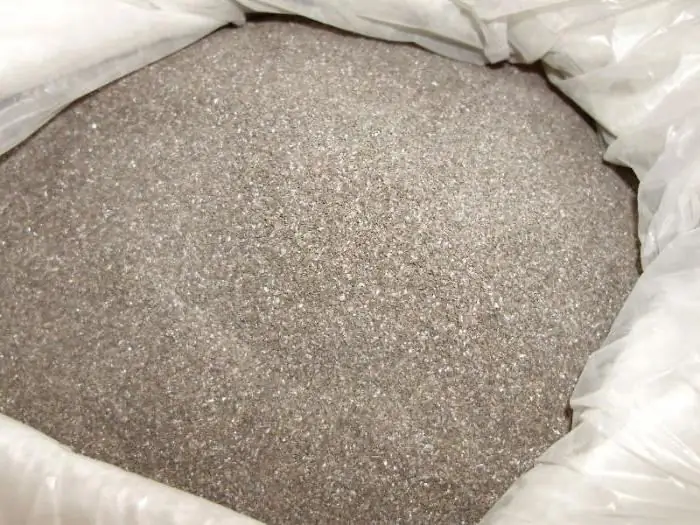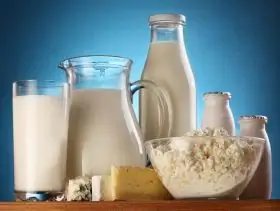2025 Author: Howard Calhoun | [email protected]. Last modified: 2025-01-24 13:10:37
Milk is one of the most important food. Nature is arranged in such a way that from the first day of life, newborn children and young mammals feed only on mother's milk. It contains all the necessary substances for the normal functioning of the growing organism. But even, becoming older, a person does not refuse milk. We use it both in its natural form and in processed form (fermented baked milk, yogurt, cream, sour cream, cottage cheese, butter). There is whole and skimmed milk, steamed and baked, condensed and … dry. And if everything is more or less clear with fermented milk products, then the last two are of great interest, especially among children. Surely the little fidget pestered you with the question: “What is milk made of?” In this article, we will try to find an answer to it and learn a lot about the product familiar from childhood.

What real milk is made of
Of course, if you think about it, the question “what milk is made of” seems silly. But it only seems. Of course, we are not talking about a natural product. Another thing is purchased milk. What is it made from? A similar question from the lips of a city kid can be heard quite often, and there is no need to be surprised. In fact, this is the same cowmilk, it just goes through processing before it gets to our table. Some unscrupulous manufacturers may dilute it with water or add vegetable fats to increase its fat content. But this is extremely rare. Most milk is made from natural raw materials.
Composition
It should be noted that people are used to eating not only cow's milk - in some regions it is obtained from female deer, goats, mares, buffaloes, camels. The chemical composition of these products, of course, varies. We will focus on the cow, since it is most often present on our table. So, it contains about 85% water, 3% protein (it is called casein), milk fat - up to 4.5%, up to 5.5% milk sugar (lactose), as well as vitamins and minerals. At factories and dairy factories where milk is made (more precisely, processed), much attention is paid to fat content and protein content. With a high fat content of the original product, the yield of butter is greater, and protein is important in the manufacture of cottage cheese and various cheeses.

How milk is made at the factory and dairies
On the shelves of numerous stores you can always find milk. But before it gets there, it goes through processing. It is necessary in order to secure the product. Of course, useful properties are lost in this case, but a part still remains. Let's consider these processes in order. Raw milk entering the plant is first cooled and then homogenized. Homogenization is necessary so that when filling milk intopackages on the surface did not settle cream. In fact, this is milk fat, which is broken into small balls in a homogenizer, evenly distributed throughout the mass of milk. This improves the taste of the original product, increases its digestibility. This is followed by heat treatment (it is necessary for the disinfection of milk, since it can contain not only beneficial microorganisms, but also pathogens) - this can be pasteurization, ultra-pasteurization or sterilization.

Types of heat treatment
The first method is considered the most common. It is the most sparing and allows you to maximize the preservation of not only taste and smell, but also useful properties. In addition, after pasteurization, milk is stored longer than usual. In modern industry, ultra-pasteurization is increasingly being used. This method differs from the previous one in the use of ultra-high temperature. Of course, there are no useful properties left in it at all. Sterilization is also characterized by high temperature processing. Such milk is stored the longest (up to 6 months or even up to a year). As a rule, heat treatment is followed by bottling into polyethylene or plastic containers and sale through retail chains.
About milk powder

In addition to ordinary milk, there is also dry milk. Probably not every one of us knows how milk powder is made. For the first time, this product became known back in 1832, when the Russian chemist M. Dirchov founded itproduction. In fact, to the question: “What is powdered milk made of?” the answer is simple: from natural cowhide. The process consists of 2 stages. At the first stage, the milk is condensed in high-pressure machines. Next, the resulting mixture is dried in special devices. As a result, a white powder remains - this is milk powder, or rather its dry residue, which has lost 85% of its volume (water). The only advantage of such a product over whole milk is the possibility of its long-term storage. Plus, it takes up little space, which is very important when transporting. The composition of powdered milk is the same as that of whole milk, it just does not contain water. What powdered milk is made of is now clear. Let's move on to its scope.

Where milk powder is used
How milk powder is made, we found out, now let's look at where it is used. Most often it is common in those regions where there is no possibility of obtaining a whole natural product. The powder is simply dissolved in warm water (in a ratio of 1 to 3), and then it is already used for its intended purpose. Also, milk powder is the basis for the production of baby food (dry milk porridge) and feed for small calves. The product can be found in the free market.
About baked milk
There is another type of this indispensable product for humans - baked milk. Many of us are probably wondering how baked milk is made. Its difference from the whole is the pronounced taste of pasteurization and the presence of a creamy shade. The process presents the following picture:whole milk is mixed with cream until a mass fraction of fat in raw materials is 4 or 6% (this process is called normalization). Then the mixture is subjected to homogenization (this process is mentioned above) and pasteurization with a long exposure (about 4 hours at a temperature of 95-99 ºС). At the same time, the raw material is periodically mixed so that a film of proteins and fat does not form on its surface. It is the prolonged exposure to temperature that contributes to the appearance of a cream color (milk sugar actively interacts with amino acids, as a result, melanoidin is formed, giving such a shade). The final stage is cooling and pouring baked milk into containers. That's all wisdom. It should also be noted that ryazhenka and katyk are produced from fuel oil (this is what people call this type of milk) (different starters are used in their preparation, as a result, a fermented milk product with a thick consistency and taste of baked milk is obtained).

About skimmed milk
Very often in the dairy departments of stores you can find a package with the inscription "Skimmed milk". What it is? In fact, this is ordinary milk, just without fat, that is, without cream. As a rule, the percentage of fat here is no more than 0.5%. How is skimmed milk made? It is obtained by separating the whole product in special devices - separators. There, the separation of cream from milk occurs under the action of centrifugal forces. The result is a fat-free liquid.

Scope of low fatmilk
Milk packaging always indicates the exact amount of fat and protein in the product. It should be noted that it is impossible to obtain milk with a specific fat content from a cow. This indicator is not the same even for one cow in different seasons. Since GOSTs have their own standards and requirements, milk has to be normalized skimmed in order to end up with the required fat content (2.5%, 3.2% or 6%). Also, such milk is used for the production of low-fat kefir, cottage cheese or yogurt. You can buy it in packaged form at any store. It costs, of course, cheaper than usual.
You can talk about milk and its benefits indefinitely. No wonder we have always been told since childhood: "Drink milk - it is very useful." And it's true, our life begins with it - immediately after the birth of the baby, they must be applied to the chest so that he receives the first portion of nutritious colostrum. Thanks to mother's milk, the child's immunity is strengthened, the baby grows and develops. Surprisingly, in the first months of life, it fully satisfies the child's needs for water, nutrients, vitamins and minerals. Surely any of us noticed that the basis of a he althy and proper diet is always dairy and sour-milk products. For growing babies, cottage cheese is very useful, it contains a lot of calcium, which is necessary for the growth of bones and he althy teeth. Doctors also recommend that older people include milk in their diet, as bones rapidly lose calcium during this period of life. Whatever one may say, this product is irreplaceable. In this article, we reviewedwhat milk does, what types of it exist and how it is useful. Surely you have learned a lot of new and interesting things for yourself. Stay he althy!
Recommended:
Coating steel with titanium nitride. Powder technology

To cover materials in our time, a whole range of different technologies is used. There are vacuum coating technologies, electron-proton radiation, high-temperature synthesis and many others. In the modern world, "gilded" decorative ornaments and products are becoming more and more popular
Abrasive powder: production, consumption. Where can abrasive powder be used?

Abrasive powder is mainly used to clean metal surfaces from rust. Most often, for this purpose, its varieties such as cooper slag and nickel slag are used. Diamond powder is used to make abrasive pastes and grinding tools
He althy food basics: how to skim milk powder

The use of skimmed milk in some cases is simply necessary. Recently, this product is gaining more and more sympathy among consumers. Skimming milk powder is quite simple. What is its feature?
Copper powder: production, purpose and application

Copper powder is a product widely used in the paint and varnish, chemical, automotive, instrument making, and nanotechnologies industries. There are several main brands of such a product. And all of them are produced in accordance with the standards stipulated by GOST
How were matches made before and how are they made today? Swedish matches

The article is devoted to the history of the creation of matches - from their very first prototypes to modern ones. It also tells about the famous Swedish matches, the evolution of the chemical components of the match head and stickers for the box

